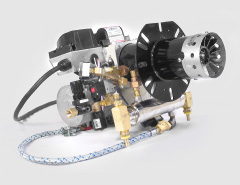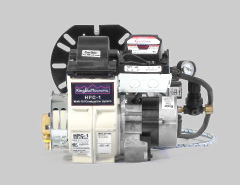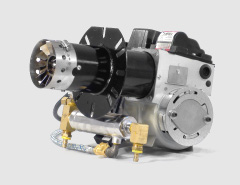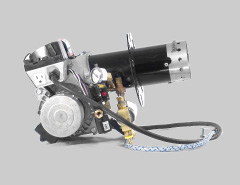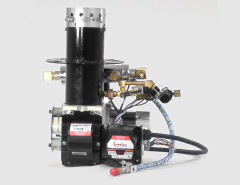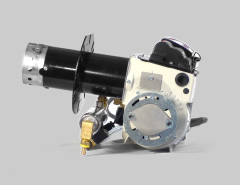Check out our FRESHLY PATENTED - Worlds first and only - Hydronically Preheated Multi-Oil Combustion System!
We spent a lot of time, blood, sweat, and tears writing and fighting for this patent, and thought we'd share it with you. Read on to learn why we our unarguably the best mult-oil combustion system on the market!
This claims the benefit of provisional patent application serial number 60/320227, filed on 2003-05-28 by Ryan Bechard.
Background of Invention
This invention relates generally to heating appliances such as furnaces and boilers, specifically for the purpose of preheating heavy oil fuels for combustion.
Considerable waste oil is generated as a result of the spent oil garnered from the crankcases of millions of automobiles and trucks whenever the oil is changed. The disposal of the vast quantities of discarded oil constitutes a great problem. Some waste oil is cleaned and is then re-sold. Unfortunately, many people choose to illegally dump oil rather than pay to have it properly disposed.
When properly performed, efficient and complete incineration of waste oil provides many benefits. While large waste oil generators often receive a small reimbursement for their waste oil, smaller generators, usually end up paying to have it removed off site. Retaining waste oil and utilizing it for heating, versus burning a purchased fuel, results in immediate savings. In most cases, the cost of waste oil heating equipment is returned in one to three years. With this invention, the cost of preheating and maintenance is minimized, the savings are greater and therefore the return on investment faster. Incineration of waste oil is a government approved and encouraged method of recycling providing elimination of a substance considered hazardous.
Four process elements are needed for the combustion of heavier virgin heating and spent lubricating oils. First, and most importantly, because heavier oil fuels are too thick to atomize and spray at ambient temperature, they must be preheated. The heated oil becomes reduced in viscosity enabling it to be finely atomized.
Second, is the atomizing of heated oil. Atomization is accomplished by spraying heated oil out of a nozzle. An aeration process involving an air atomizing nozzle and compressed air is one method. The air atomizing nozzle mixes oil and compressed air resulting in a conical fine spray of atomized oil ejecting away from the nozzle. Typically only 10-15 pounds per square inch of air pressure along with 1-10 pounds per square inch of oil pressure is all that is needed. Another method of atomization is accomplished by substituting the nozzle with a standard oil pressure nozzle and placing the oil under higher pressure, typically 100-150 pounds per square inch. With this invention, either method of atomization can be used.
Third, is igniting the atomized oil. This process ignites the spray and creates the combustion flame that incinerates the atomized oil. The ignition process is typically performed by an igniter which has a pair of electrodes which emit an electrical arc across in close proximity to the atomized spray.
Fourth, is controlling all of the processes needed for combustion. It is important that the combustion process be performed in a way that is precisely controlled with safety components and features to assure a safe, reliable and thorough incineration of oil. The control system empowers and manages all the mechanical and electro-mechanical devices needed to control all the process elements mentioned above.
Most prior art oil combustion preheat systems use thermostatically controlled high wattage electrical heating elements to preheat oil. This invention utilizes a heated liquid to preheat oil. All heavy oil fuels need to be preheated in order to yield the fluid flow characteristics that combustion equipment requires.
This invention is a multi oil preheat device used within a combustion system for the incineration of many types of oils. This invention transfers heat energy from a heated liquid to oil prior to being incinerated. This method produces many advantages over prior art's thermostatically controlled electrical element preheat systems. The heated liquid this invention uses can come from any source including a boiler that the invention is installed on. When the invention is installed on a boiler it is able to utilize the heat energy created by the combustion process itself versus consuming electricity to create heat energy for preheating.
Prior art's method of preheating oil requires an outside source of electrical energy to energize electric heating elements. These elements heat a device that the oil flows through just prior to reaching a nozzle. The oil is heated by one or more electrical elements either in direct contact with the electrical element or indirectly by conduction through the body of the preheat device.
U.S. Patent Number 5,067,894 to Bender in 1991 shows a preheat device located inside a burner constructed of an elongated square metal block that has electrical elements installed inside of it. U.S. Patent number 5,341,832 to Foust in 1994 shows a preheat device located in a burner constructed of a metal cylindrical preheat device that has electrical elements installed inside of it. U.S. Patent 5,551,868 to Smoker et al. in 1996 shows a preheat device located inside a burner constructed of a rectangular metal block which also has electrical elements installed inside of it.
U.S. Patent 5,879,149 to Briggs et al in 1999 shows a canister shaped preheat device located external to the burner. Inside the preheat device is an electric element which is inserted into a metal apparatus. The element apparatus assembly is installed inside a cylindrical canister. Oil enters the canister and is heated as it passes around the element apparatus assembly. Oil then travels from the external canister to yet another electrically powered preheat device located inside the burner.
These are just a few examples of the many patented preheat inventions that accomplish similar results using thermostatically controlled electric elements to preheat oil. The prior art preheat devices all entail one or more electric elements that are thermostatically controlled in various shapes, configurations and locations on or in a burner. These prior art inventions all consume a significant amount of electricity to preheat oil for combustion. These electrically preheated burners loose a percentage of their oil energy savings due to their high electrical consumption.
Another disadvantage with prior art's preheat devices is that thermostatically controlled electrical elements are slow to react. When used to preheat oil, their method produces temperature fluctuations of the oil's temperature in the preheat process. These temperature swings mandate frequent maintenance and create many problems within a combustion system.
Within the prior art's electrically heated preheat device, oil is vulnerable to overheating at the high peak of an electrical element's temperature swing. Over heated oil produces carbon crystals within the preheat device causing coagulation and clogging of the oil passageway and nozzle resulting in equipment failure. Oil is vulnerable to carbonization at temperatures as low as 90 degrees Centigrade. The surface temperature of an energized electric element can reach several hundred degrees centigrade.
At the low end of the thermostatically controlled electrical element's temperature swing, the quality of oil atomization decreases. This often happens before prior art's thermostat turns on the electric heating elements because the thermostat is slow to react to the oil temperature. When oil cools, it thickens, thus reducing the quality of oil atomization as the oil droplet size increases. These larger droplets, if not completely incinerated, will project past the flame where they can accumulate and build up unburned fuel inside the furnace or boiler. This unburned oil fuel accumulation can propose a serious hazard to the end user.
Within this invention, a heated liquid of consistent temperature is circulated. Heat energy is exchanged from the heated liquid through the device to the oil as it passes through the device. The oil is brought to and maintained at an optimal atomization temperature with minuet temperature fluctuations prior to combustion. With this invention, oil can not reach a temperature any hotter than the liquid with which it is being heated. With this invention's method of preheating, carbon creation is eliminated because preheat temperature fluctuations are vastly minimized. Whereas oil is vulnerable to carbonization from direct overheating, a liquid such as a water glycol solution is not. Using a liquid to convey heat energy to oil for preheating removes the risk of overheating and carbonizing oil. The liquid acts as a buffer that absorbs temperature extremes and fluctuations between the heat source and oil.
A significant disadvantage of using prior art's electrical elements to preheat oil is their tendency to overheat the oil. Over time, this causes the oil to carbonize inside the preheat device thus creating many problems in the combustion process. The carbon crystals created by overheated oil, will plug the nozzle causing equipment failure. The coagulation of carbonized oil inside the passageways of the prior art's preheat device restricts the oil flow causing inconsistent combustion and eventual equipment failure. Carbon build up inside the oil channels insulates the oil from the heat source.
Gradual carbon coagulation on the inner surface of the heat transfer boundaries forces prior art's electric elements to remain on longer thus further increasing carbon build up. Eventually the prior art's preheat device must be removed from the heating appliance, disassembled, cleaned out, reassembled and reinstalled back onto the heating appliance. An operator of the prior art preheat invention is typically required to send the combustion system back to the manufacture or qualified manufacture's distributor to have the overhauling process performed. This problem is so prevalent in the industry that manufactures, or their distributors, offer customer training on overhauling procedures. Overhauling costs an owner of the prior art inventions a significant amount of time and money to keep the system operable.
This invention uses a heated liquid that is maintained at approximately 80 degrees centigrade to preheat oil minimizing temperature fluctuation. Since the oil's temperature can't exceed the heated liquid's temperature, carbon creation and the removal thereof does not need to be performed. This significant advantage makes this invention much more attractive to the end user.
The prior art's preheat devices using thermostatically controlled electrical elements, once energized, heat up very slowly, typically 5 to 15 minutes. Because they heat up slowly, they must keep the oil hot inside the preheat device in between burn cycles in order to be prepared for the next burn cycle. The time between burn cycles is when the majority of carbonization forms due to the constant overheating of the dormant oil inside the device.
With this invention, the oil is heated rapidly, typically within 15 to 30 seconds, prior to a burn cycle. The oil is heated from an ambient temperature to an ideal temperature for atomization just prior to a burn cycle. Because of the high speed of heat conduction from the heated liquid to oil, this invention does not need to keep the dormant oil inside the preheat device heated in between burn cycles. Also, electrical energy consumption needed to keep the dormant oil heated between burn cycles is eliminated.
Another disadvantage of using thermostatically controlled electric elements to preheat oil is that of reduced safety. Because of high element temperatures, prior art preheat systems must implement vast safety systems to prevent a fire. In the event that the prior art's control system were to fail causing an element to remain energized, a potential fire hazard could occur. Prior art's control system is extremely complex with sensors, switches, wiring and controllers to prevent a hazardous condition. In summary, using thermostatically controlled electrical elements to preheat oil is inefficient, undependable, potentially hazardous and is expensive to maintain.
Using a heated liquid to preheat oil is extremely safe. No fire hazard is caused by circulating a liquid between the heated liquid source and the invention. The control system for this invention simply energizes a pump to circulate a heated liquid. There are only a few components involved with this preheat invention. The prior art's preheat systems involve many moving parts, sensors, wiring, controllers and components vulnerable to failure causing equipment malfunction and a hazardous condition.
A significant advantage of this invention is having the option of capturing and utilizing heat energy from the combustion process to preheat oil rather than consuming electricity to create heat energy for preheating. The method of using a heated liquid does not overheat oil eliminating the many problems caused by carbonized oil creation and large preheat temperature fluctuations as found in the prior art. Therefore, the cost of incinerating multiple oil fuels with this invention is significantly less than the prior art.
The multi oil heating market has long sought a reliable and cost effective means of incinerating heavier oil fuels for heating purposes and waste oil elimination. Many oils such as spent lubricating oil, industrial heating oil and cooking oils burn very efficiently when appropriately preheated and incinerated within a combustion system. In an age demanding higher efficiencies with regard to energy usage, this invention provides a much more efficient method of incinerating both heavy virgin and used oil fuels.

